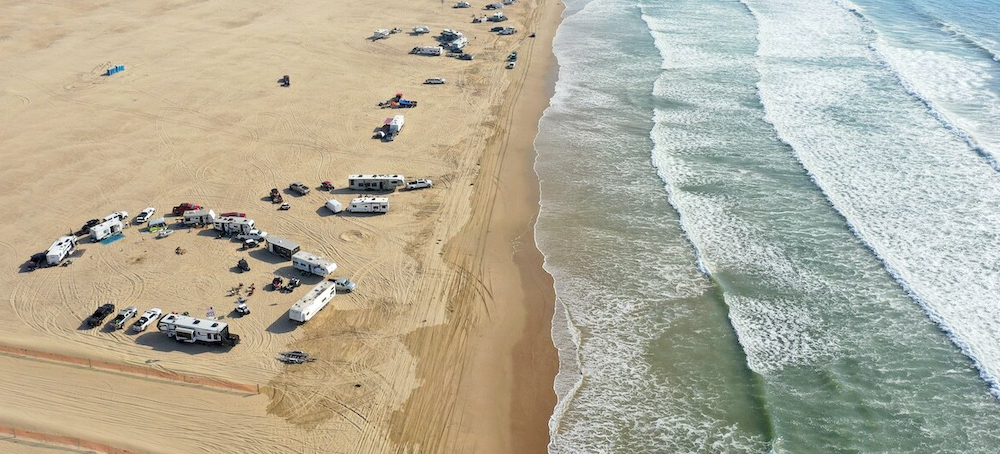California’s First National Marine Sanctuary in Over 3 Decades Will Protect 116 Miles of Coastline
Cristen Hemingway Jaynes EcoWatch Part of the proposed Chumash Heritage National Marine Sanctuary along California’s Central Coast near Grover Beach, California on Sept. 21, 2023. (photo: Mario Tama/Getty Images)
Part of the proposed Chumash Heritage National Marine Sanctuary along California’s Central Coast near Grover Beach, California on Sept. 21, 2023. (photo: Mario Tama/Getty Images)
The designation process reached a major milestone last week when the final environmental impact statement (FEIS) for the marine sanctuary was released.
Under the preferred alternative of the National Oceanic and Atmospheric Administration (NOAA), the Chumash Heritage Sanctuary would cover 4,543 square miles of offshore and coastal waters along more than 100 miles of the central coast of California, a press release from NOAA said.
“This is a huge moment for the Chumash People and all who have tirelessly supported our campaign over the years,” said Violet Sage Walker, Northern Chumash Tribal Council chairperson, in the press release. “My father, the late Chief Fred Collins, began the journey to protect these sacred waters 40 years ago, and we have been so proud to continue his work. I am delighted to celebrate his vision, today’s success, and the future of our People who will always be connected to past, present and future by this special stretch of coastline and the true magic its waters hold.”
Theo FEIS comes almost a decade after Tribes, Indigenous Peoples, leaders in the community, organizations, state and local officials, businesses and members of Congress began the designation process. The environmental impact statement evaluates the projected environmental, economic and social effects the proposed sanctuary would have, as well as reflects the public input given during multiple stakeholder engagements.
“Efforts to make the Chumash Heritage National Marine Sanctuary the first Indigenous-focused sanctuary nomination have spanned many years — and today’s milestone is the product of committed individuals working together across backgrounds, across sectors and across governments to advance co-stewardship while respecting Indigenous Knowledge,” said Brenda Mallory, chair of the White House Council on Environmental Quality. “Under President Biden and Vice President Harris’s leadership, we will achieve a lasting legacy that accounts for a shared and common heritage for all to treasure while also building a clean energy future and combating the climate crisis.”
The proposed sanctuary would become the 17th in the National Marine Sanctuary System, contributing to the Biden-Harris Administration’s America the Beautiful initiative. The initiative supports local conservation efforts to preserve and restore a minimum of 30 percent of the country’s lands and waters by the end of the decade.
“Today, our Administration is taking a critical step toward designating the first Indigenous-proposed National Marine Sanctuary,” Vice President Kamala Harris said in the press release. “As a Senator, I was proud to support efforts to create the Chumash Heritage National Marine Sanctuary off California’s coast to honor our commitments to Indigenous communities and promote natural spaces.”
The sanctuary would recognize and celebrate the connections of Indigenous Peoples to the region, as well as be managed with active Tribal and Indigenous community involvement that encompasses Indigenous knowledge, values and traditions.
“The sanctuary is anticipated to bring comprehensive community- and ecosystem-based management to nationally significant natural, historical, archeological and cultural resources — including kelp forests, rocky reefs, sandy beaches, underwater mountains and more than 200 shipwrecks,” the press release said.
The National Environmental Policy Act requires NOAA to wait 30 days following publication of the FEIS before it can make its final decision regarding designation.
National marine sanctuaries promote the protection and long-term conservation of the region’s natural and cultural resources that local economies rely on.
“Every tribal nation across the country maintains a significant cultural tie to its aboriginal lands and waters. Sadly, for many, those connections have been difficult to reach. But today, with this announcement, the Chumash people take great strides in restoring our connection to our maritime history,” said Kenneth Kahn, chairperson of the Santa Ynez Band of Chumash Indians, a planned co-steward of the sanctuary.
As outlined in the FEIS preferred alternative, the national marine sanctuary’s boundaries would not include places that are planned sites for offshore wind turbines or wind energy transmission cables. However, a potential proposed sanctuary expansion would be considered by NOAA in the future, after approval of the transmission cables.
“The Chumash Heritage National Marine Sanctuary will be a step forward for communities and nature alike,” said Governor of California Gavin Newsom in the press release. “By respecting and supporting tribal leadership and stewardship, we are bringing California one step closer to meeting our aggressive clean energy goals while protecting biodiversity — and above all else, honoring the land and waters alongside those who have stewarded this area since time immemorial.”



